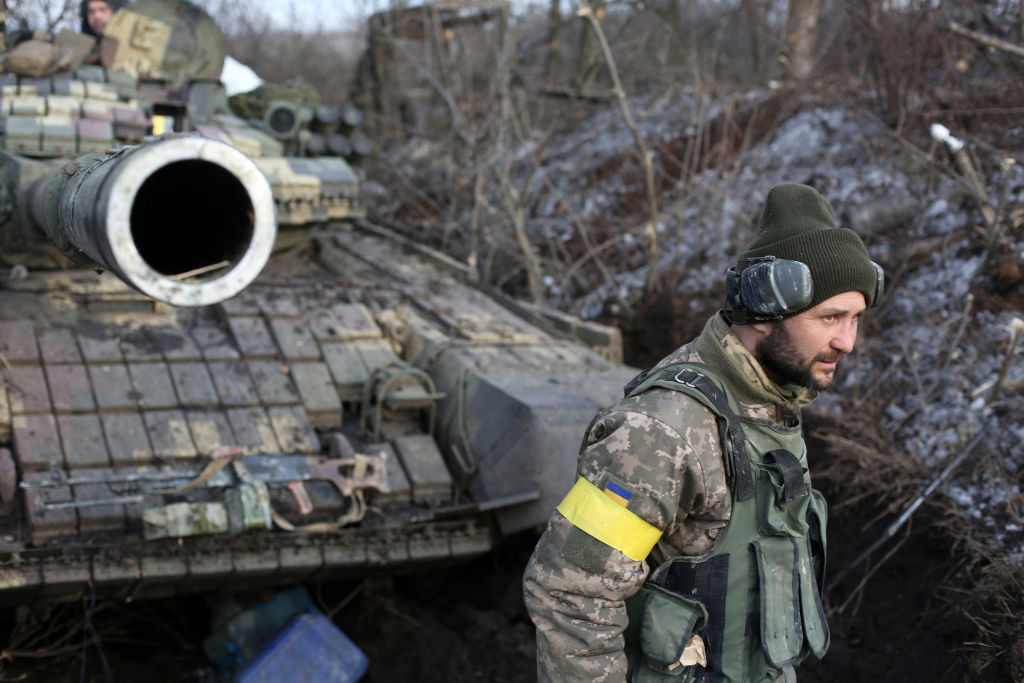It didn’t take long for the Kremlin to exploit the news that Britain will be supplying depleted uranium armour-piercing anti-tank ammo to Ukraine. On Tuesday, Putin said that ‘Russia will have to respond accordingly, given that the West collectively is already beginning to use weapons with a nuclear component.’ While on Wednesday, Russia’s Ambassador to the US said that the West had ‘irrevocably decided to bring humanity to a dangerous line, beyond which a nuclear Armageddon is looming ever more distinctly.’
Both remarks are part of a long-standing Russian attempt to suggest that the Ukraine conflict might lead to nuclear escalation. The aim is to disrupt international support for Ukraine. The idea that the Kremlin will actually respond to the UK sending depleted uranium armour piercing rounds to Ukraine is highly unlikely though.
It’s worth making clear why the UK is sending depleted uranium ammo to Ukraine in the first place. The issue, at its heart, is that piercing tank armour is very difficult. The armour is formed from specially layered hardened steels, and tanks are designed to only show angled surfaces to their adversaries, increasing the chance that an attack will glance off. In addition, tanks often have what is called ‘reactive armour’ plates on their outside, which blow outwards after impact, sending energy away from rather than towards the tank. They also have spall lines on the inside which catch fragments from shockwaves passing through the armour plates. Moreover, because tanks have cannons and can see and shoot targets 2 km away, attackers want to make sure that if they hit a tank, they break through its armour.
There are three basic types of anti-armour projectile that the UK will have considered sending to Ukraine. First there are High Explosive Anti Tank (HEAT) munitions, which use a shaped charge to drive a metal jet through a tank’s armour. These munitions though are less suitable to be fired from tanks because of the fixed diameter of a tank cannon – which is why the UK is sending a different type of munition to Ukraine.
Another method for defeating tank armour is a High Explosive Squash Head (HESH) munition. A HESH round works by planting plastic explosives on a tank’s surface. When this detonates it sends a shockwave through the target and causes it to break apart from the inside. HESH rounds are highly effective against bunkers. Against modern tanks they are often disrupted by reactive armour – which sends the impact away from the tank – and spall liners. This is why if the UK wants to help Ukraine defeat Russia’s tanks, it is not the most suitable type of munition either.
The third way of defeating armour is with a kinetic penetrator. This works by punching through armour with kinetic energy. This ammunition usually has a large mass, exceedingly high velocity, and concentrates the impact on as small an area as possible. This is what is called an Armour Piercing Fin Stabilised Discarding Sabot (APFSDS) round. It is essentially a dart, the effectiveness of which is determined by its density, length – which is the best way to increase weight – and speed. The APFSDS then flies as straight a trajectory as possible to hit its target with maximum force.
It is in APFSDS rounds where depleted uranium is useful. When two objects collide the softer material deforms, and this means that its energy is dissipated. Kinetic penetrators therefore work best if they are denser than the material with which they collide. For this reason APFSDS rounds are either made with a Tungsten alloy or with depleted uranium, both of which are exceedingly dense materials.
This doesn’t mean the UK is sending nuclear weapons to Ukraine, as Putin has suggested. Depleted uranium is… depleted. It is a by-product of producing nuclear fuel and not itself relevant for nuclear weapons. In fact, it is often used in medical equipment and other fields where shielding from radioactivity is required. It is still radioactive. Most things contain some radioactive material, however. If you buy a Geiger counter and put it near your household appliances, you will see varying levels of radiation emitted by them. The level may vary, but in most cases it is all harmless.
Depleted uranium is not harmless, but it is far less radioactive than natural uranium and it is not used as a weapon because of its radioactivity. I wouldn’t recommend Russian soldiers go to sleep cradling a depleted uranium round, or lick the tip of the ammunition – depleted uranium is still toxic. But when Russian troops do come into contact with one of these projectiles, the fact that the uranium will be travelling at around 1,800 meters per second and burning up as it flies will be more concerning to any target than its radioactivity.
Putin’s claim that there is a nuclear element to the weapon is a dead cat: an attempt to scare people over the issue. This is a leader who had his soldiers dig trenches in Chornobyl’s red forest – literally lying for days among radioactive particles – and shelled the Zaporizhzhia nuclear power plant. By comparison the level of radiation given off by depleted uranium anti-tank rounds is paltry. The destruction of his tanks on the other hand is clearly not the outcome he is hoping for.






Comments